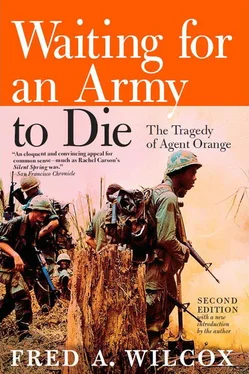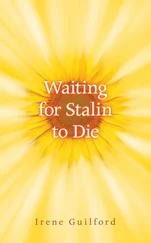“No, neither I nor anyone else has, or probably ever will, for several reasons. In general the latency period for induction of cancer into an animal is correlated with the life span of the animal. So one can get skin cancers in mice by painting them with polyaromatic hydrocarbons for just a matter of weeks or months, but then a mouse only lives for about a year and a half. Some years ago a researcher here was trying to reproduce these sorts of things in monkeys by painting them with polyaromatic hydrocarbons and exposing them to ultraviolet light. And he finally pretty much gave up. But several years later the animals were still around and did begin to show up with skin cancers. So it just isn’t practical, at least in the research environment today, to conduct an experiment that would go on for twenty or even forty years, particularly when there is no evidence that TCDD is carcinogenic in animals or humans.”
Observing my surprise, McNulty points to a large file drawer and declares: “It’s all there, and it’s all, or at least 90 percent of it, negative.”
But McNulty’s insistence that TCDD has not proven to be carcinogenic in laboratory animals or humans only demonstrates, once again, that scientists disagree on just how much and exactly what kind of damage TCDD does to living organisms. For example, Dr. Samuel S. Epstein, a human and experimental pathologist and toxicologist who has devoted the past thirty years to the study of the hazardous effects of chemicals and chemical pollutants believes that “TCDD is the most potent known carcinogen.” An expert on the delayed and chronic toxic effects—most notably cancer, reproductive, and genetic—of chemicals and chemical pollutants, including pesticides and herbicides, Epstein testified before the House Subcommittee on Medical Facilities and Benefits of the Committee on Veterans’ Affairs that
In tests with small groups of rats over a dose range from 1 ppt (0.0003 ug/kg) to 1000 ppb (500 ug/kg), all animals receiving doses in excess of 500 ppt died within 95 weeks. TCDD induced a wide range of malignant tumors in doses as low as 5 ppt (Van Miller et al., 1977). These included squamous carcinomas of the lung, cholangiosarcoma of the liver, and malignant histiocytomas at 1 and 5 ppb levels, and carcinomas of the ear duct, kidney and skin, malignant histiocytomas and testicular tumors at the 5 ppt dose. In more large-scale carcinogenicity tests by Dow Chemical, which are generally confirmatory on the Van Miller studies, TCDD was administered orally to rats at levels of 0.001, 0.01 and 0.1 ug/kg (Kociba et al., 1978). Carcinomas of the liver, lung, palate and tongue were induced at the highest dose levels, neoplastic liver nodules at the intermediate dose level, and toxic liver effects at the lowest dose level tested. 6
Contradicting the VA’s contention that there is no evidence that TCDD is harmful to humans, Dr. Epstein told the subcommittee about a study of forestry, paper pulp, and sawmill workers in northern Sweden who were exposed primarily to 2,4,5-T and 2,4-D. The study concluded that the risk for soft tissue sarcomas in the Swedish workers was five times greater than in those not exposed to these herbicides. 7A “statistically significant excess of stomach cancer” was also found in Swedish railroad workers exposed to phenoxyacetic acids and amitrole over a ten-year period, 8and a study conducted in southern Sweden found “statistically significant excess risks for soft-tissue sarcomas.” 9In the follow-up of the 1953 Ludwigshafen (West Germany) accident in a TCP plant, a seven-fold excess in stomach cancer over expected rates was noted. 10
Among Vietnam veterans, Epstein testified, “the incidence of testicular cancer appears high, even allowing for selection bias. In one group of about 5,000 plaintiffs, approximately 200 testicular cancers, mainly seminomas, have been recognized. There are also suggestions of an increased incidence of lymphomas and leukemias.” When Dr. Epstein described the “symptomatology” of TCDD in human beings, which he said is “well recognized in the clinical and toxicological literature,” he might very well have been a Vietnam veteran talking about some of the problems he had experienced since returning from Asia. TCDD, said Epstein, “is a potent multi-system toxic agent producing a panoply of a wide range of acute and delayed effects, many of which can progress to the chronic. Recognized clinical symptoms include asthenia, muscular weakness, pains in limbs and joints, insomnia, photosensitivity, nausea, vomiting and diarrhea. Recognized signs include abnormalities in liver function, porphyria, peripheral neuropathy, elevated blood triglycerides and cholesterol, and psychological and personality changes… This disease complex is generally consistent with that recognized in preliminary surveys of Vietnam veterans, although no large-scale analysis has yet been published.” [20] See Appendix, Letter to the Editor of the Journal of the American Medical Association , 195–196.
What Epstein did not tell the subcommittee is that thousands of Vietnam veterans have been complaining of these very symptoms for a number of years, only to be given a Rorschach or Minnesota Multiple Personality Inventory (MMPI) test by VA hospital staff and sent home—or, all too often, to the psychiatric ward with a prescription for uppers or downers. Unfortunately Valium and Thorazine have not proven very effective in arresting liver cancer, and Gelusil (an antacid) seems not to have acted as an antidote to the destructive effects of TCDD on the stomachs, colons, livers, and even prostrate glands of many young veterans.
Although many studies have shown that TCDD is carcinogenic in laboratory animals and there is now suggestive evidence that “exposure to phenoxy acids and chlorophenols might constitute a risk factor in the development of soft-tissue sarcomas,” 11the VA has failed to conduct a national outreach program that might determine just how many Vietnam veterans are ill, have died, or may be dying from various types of cancer. With over a quarter million employees and a yearly budget of approximately $24 billion, the VA’s failure to do cohort studies, says Victor Yannacone, is based not on scientific caution but on a singular lack of compassion.
“I can go to my terminal in my little country law office in Patchogue,” says Yannacone, “and I can sit there and I can ask my relatively inexpensive computer to tell me the names and addresses of every veteran with testicular cancer. That is not terribly hard. I can tell the computer to tell me who had testicular cancer and the birth defects, and who was a Marine, and who served in a particular place during the month of January or February of 1968… It takes two minutes and forty-five seconds to get the answer.
“Why hasn’t the government done this kind of study? Because, quite simply, they don’t really think the veterans are that important; the Vietnam veteran is an expendable commodity to the US government.”
Yannacone, whose first brief against the manufacturers of Agent Orange was 184 pages long and contained “every piece of scientific data that was then known about dioxin or phenoxy herbicides,” believes that many veterans have already died from the “wasting effects” observed in rhesus monkeys by Dr. Wilbur McNulty and researcher Dr. James Allen. “People under the age of thirty-five don’t waste away and die with an autopsy report that says the veteran looked considerably older than his stated age of thirty-two years. He looks like a ninety-six-year-old mummy fresh out of the tomb. There isn’t a single piece of measureable fat on his skeleton. Now, that is ten years after his tour in Vietnam. What does that mean? It means somehow the amount that was loaded in his fat was mobilized and eventually killed him, and it killed him as if he had an acute dose years before. It just took ten years instead of ten days.”
Читать дальше











